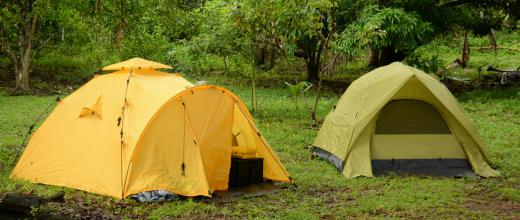At Sports&Hobbies, we're committed to delivering accurate, trustworthy information. Our expert-authored content is rigorously fact-checked and sourced from credible authorities. Discover how we uphold the highest standards in providing you with reliable knowledge.
What are Different Types of Tent Stakes?
Tent stakes are nearly as important as the tent itself. Today’s tents are often designed to withstand the elements, keeping occupants protected from changes in weather. However, they are not built to stand up against much wind. As such, tent stakes are vital for keeping your tent where you want it - on the ground.
Tent stakes may be made of plastic, metal, or wood. Each type is designed for use in certain types of terrain. For example, small diameter titanium stakes are designed for use in hard dirt. They should not be used when pitching a tent on sand or for snow camping.

Another type of tent stake, bulky angle iron/aluminum stakes, are useful for camping in the sand. This type of stake, however, is far from effective for use in hard dirt. Furthermore, these tent stakes are known to lose their effectiveness in rainy conditions.
Large plastic tent stakes are often used for family camping. These tent stakes are both lightweight and tough, featuring a large head for easier pounding into the ground. These stakes are less expensive than many other types. Keep in mind that exposure to ultraviolet light may degrade plastic stakes.
Skewer tent stakes are lightweight and inexpensive. They are straight in shape and are not the best option when holding power is vital. Generally speaking, skewer stakes work the best in grassy terrain. By contrast, bulldog tent stakes are heavier and more capable of holding fast. They don’t bend easily and work well in a variety of ground types.
Snow stakes are designed to be buried sideways in the snow. These stakes are stronger than those designed for general use. Some anchor stakes are designed for use in both snow and sand. They are made to be filled with snow or sand and buried in the ground.
Pigtails can be used in sand or soft snow. These tent stakes resemble corkscrews that have been opened or partially unwound. They are designed to be twisted in and out.
Wooden tent stakes are frequently used for securing group tents. They are generally thick and have a higher level of holding power than other types. Typically, wooden tent stakes are driven into the ground using a mallet.
You can even find glow-in-the-dark tent stakes that glow throughout the night. These tent stakes are useful for preventing tripping accidents. They are also good for setting up camp during the night.
AS FEATURED ON:
AS FEATURED ON:











Discussion Comments
It seems like no matter how many stakes come with your tent, there are never enough. I always have extra stakes on hand so I don't run out. It is easy to misplace them or leave a couple in the ground and then you end up short.
There is nothing more frustrating than not having enough stakes to tie your tent down with when you are already at your campsite.
I have a bag of metal tent stakes that I take with me every time we go camping. I have found the plastic stakes to be almost worthless. Many times they are not strong enough and will break off if the ground is very hard.
The biggest problem I have with the plastic stakes is when I am trying to remove them. They seem to be OK when it comes to holding the tent in place, but the metal ones are so much easier to work with and much sturdier.
Thanks so much for comprehensive notes about TentStakes...here is an important addition:
Check out regulations about tent stakes for camping or participation in community outdoor events.
Because of underground sprinkling systems or expensive grounds treatments, some sites prohibit all but sandbag stakes...or water or snow-filled. Ones that do not dig into the ground.
Our Town Green was flooded one year during a craft show, when a crafter's tent stake hit the underground waterpipes and it was thousand dollars in all to repair the pipes and the lawn. Very "In-tents".
If you are the co-ordinator of an event or camp-out, this is important for you. Happy Summer!
Post your comments